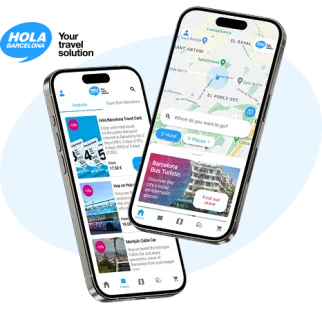Park Güell
A park and a work of art, World Heritage Site since 1984.
Park Güell is a true open-air museum, a symbol of Modernism in Barcelona where Gaudí placed architecture and urban planning at the service of his main source of inspiration: nature.
Conceived as a residential development for the wealthiest classes of early 20th-century industrial Barcelona, Gaudí designed Park Güell with the intention of creating a luxury housing area immersed in a natural setting and taking advantage of the best views of Barcelona.

Barcelona Bus Turístic, on the Hola Barcelona app
Your app for visiting the city with the Barcelona Bus Turístic: routes, stops and the most iconic places. A comfortable way to carry your tickets too!
The spaces of Park Güell
In the monumental zone of Park Güell, open every day of the year, you can visit:
- Plaça Natura: A large esplanade bordered by an undulating bench covered in trencadís, from which the entire city can be seen. It has become one of Barcelona’s most iconic postcards. Plaça Natura was intended to be the Greek Theatre of the development, a space for performances visible from all plots.
- The Hypostyle Hall: Designed to house the market of the development, the Hypostyle Hall is dominated by 86 fluted columns —some of them tilted— that support the weight of Plaça Natura. The columns contain internal pipes designed to collect rainwater falling on the square. The small domes on the ceiling are decorated with original ceramic trencadís panels incorporating everyday objects.
- The Dragon Stairway: A majestic stone staircase organized in three sections, through which water collected in the cistern beneath the Hypostyle Hall flows. At the top of the stairway is the dragon or salamander covered in trencadís, which has become the park’s icon and a ubiquitous souvenir in Barcelona shops.
- The Porter’s Pavilions: At the main entrance of what was to be the residential development are two pavilions —the one on the left intended as a concierge’s office and the one on the right as the porter’s residence. Both roofs are built with the traditional Catalan vault of flat brick, covered in ceramic trencadís. Additionally, the porter’s pavilion is topped with a mushroom-shaped dome.
How to get to Park Güell?
To reach Park Güell from the Blue Route stop, walk up Carrer de Larrard until you reach the park entrance.
Opening hours, prices, and tickets for Park Güell
Information about visiting the park, regulated and free access hours, tickets, and prices is available on the official Park Güell website.
Park Güell is open every day, but entry times vary depending on the season: low (winter-autumn), medium (spring), or high (summer-autumn). During high season, it’s harder to enjoy the park due to the higher number of visitors. To make the most of your visit, we suggest arriving early in the morning or late in the afternoon (for example, two hours before closing).
Since 2013, a ticket is required to access the monumental zone of Park Güell, the most famous area where the Dragon Stairway and Hypostyle Hall are located. This measure was introduced to prevent overcrowding and protect the heritage. You can purchase your ticket at the park’s ticket offices or online in advance (the most recommended option).
We recommend buying your ticket online through the official Park Güell website to ensure access to the paid area, as the number of tickets sold at the ticket offices is limited.
It’s very important to be at the entrance to the monumental zone on the date and time indicated on your ticket, as missing your slot means losing the opportunity to enter.
For the curious
- In terms of space, the monumental area only occupies 7.9% of the total area of the park. In fact, more than 90% is considered the free area of Park Güell
- The stone benches in Plaça Natura are ergonomic. Gaudí wanted them to adapt to the shape of the human body, and to give them shape he asked a worker to sit on them.
- Advice from a Barcelonan: The monumental area of Park Güell is only part of the immense park that Gaudí designed. The rest can be visited for free and without queues and gives access to some of the most photographed spaces in the space, such as the viaduct.
- Essential for: Art enthusiasts, modernism and nature lovers. For families with children who want to take a break from their urban visit.









